What is it granuloma annulare?
Granuloma annulare (GA) is a common skin condition in which there is mild discoloration plates. They are usually thickened and ring-shaped cancel fit. Granuloma annulare is more correctly known as necrobiotic papulosis. There are several clinical patterns.
Who gets granuloma annulare?
Granuloma annulare affects the skin of children, adolescents, or young adults (or older adults, less often).
What Causes Granuloma Annulare?
Granuloma annulare is a delay hypersensitivity reaction to some component of the dermis. Inflammation is mediated by tumor necrosis alpha factor (TNFα). The reason this occurs is unknown.
Located granuloma annulare is sometimes associated with autoimmune thyroiditis, but it does not go away with thyroid replacement. Extensive granuloma annulare is sometimes associated with diabetes mellitus, hyperlipidemia, and rarely with lymphoma, HIV infection and solid tumors
What are the clinical features of granuloma annulare?
Granuloma annulare can occur anywhere on the body and is occasionally quite extended. It only affects the skin. Granuloma annulare may not cause symptoms, but the affected areas are often tender when struck. Plates tend to slowly change shape, size, and position.
Localized granuloma annulare
The localized form is the most common type of granuloma annulare in children. One or more skin-colored bumps occur in rings on the skin over the joints, particularly the knuckles. The center of each ring is often a little depressed. Localized granuloma annulare usually affects the fingers or the back of both hands, but is also common on the top of the foot or ankle, and on one or both elbows.
Localized granuloma annulare

Granuloma annulare
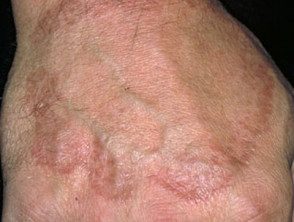
Granuloma annulare
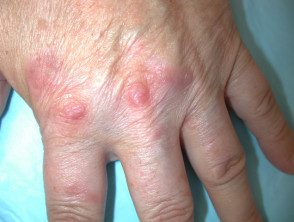
Granuloma annulare
See more images of granuloma annulare ...
Generalized granuloma annulare
Generalized granuloma annulare usually presents in adults, as generalized patches of skin color, pink or slightly mauve. the disseminated type is made up of small papules, generally arranged symmetrically in rings of 10 cm or more in diameter. They are often found around the skin folds on the trunk (armpits, groin).
Generalized granuloma annulare

Granuloma annulare
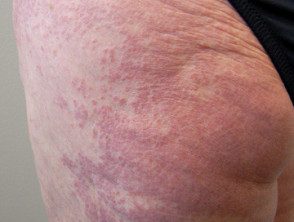
Granuloma annulare
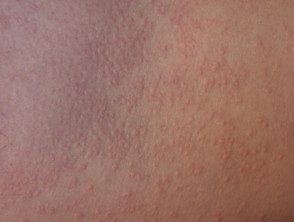
Granuloma annulare
Subcutaneous granuloma annulare
Subcutaneous granuloma annulare occurs most often in children and presents as rubbery lumps. They appear on the margins of the scalp, fingertips and pimples. Subcutaneous granuloma annulare is also called pseudo-rheumatoid nodules because subcutaneous lesions look quite similar to rheumatoid nodules. However, they arise in people who do not suffer from rheumatoids. arthritis.
Subcutaneous granuloma annulare

Granuloma annulare

Granuloma annulare
Perforating granuloma annulare
Perforating granuloma annulare describes plaques in which it was damaged collagen is eliminated through epidermis. Perforating granuloma annulare is usually located on the hands, but occasionally plaques can appear anywhere on the body, especially within the scars. Dermoscopy helps confirm the presence of perforations in small papules that arise within typical granuloma annulare plaques. Perforating lesions are often itchy or painful.
Perforating granuloma annulare
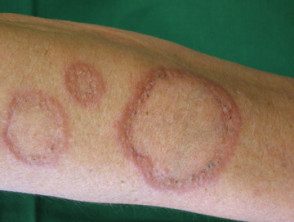
Granuloma annulare
Atypical granuloma annulare
Atypical granuloma annulare describes:
- Granuloma annulare in unusual places, such as the face, palms, and ears.
- Granuloma annulare with photosensitive distribution
- Unusually severe or symptomatic granuloma annulare
Interstitial granulomatous dermatitis
Interstitial granulomatous dermatitis is a pathological finding observed in some patients with extensive granuloma annulare or other disorders with a similar clinical presentation.
How is granuloma annulare diagnosed?
Most often, granuloma annulare is recognized clinically due to its characteristic appearance. But sometimes the diagnosis is not obvious, and other conditions can be considered. Skin biopsy usually shows necrobiotic degeneration of dermal collagen surrounded by a inflammatory reaction. See granuloma annulare pathology.
What treatment is available for granuloma annulare?
In most cases of granuloma annulare, no treatment is required because the patches disappear on their own within a few months, without leaving a trace. However, they sometimes persist for years. Treatment is not always successful.
Local therapy
Options to consider include:
- Current corticosteroid ointment below occlusion
- Intralesional steroid injections
- Destruction by cryotherapy or To be ablation
- Imiquimod cream
- Topical calcineurin inhibitors (tacrolimus and pimecrolimus)
Systemic therapy
Systemic therapy can be considered in generalized granuloma annulare. The following treatments have been reported to help at least some cases of disseminated granuloma annulare. Neither of these can be trusted to eliminate it, and there are some potential adverse effects.
- Systemic steroids
- Isotretinoin
- Methotrexate
- Potassium iodide
- Dapsone
- Hydroxychloroquine
- Pentoxifylline
- Allopurinol (note: Allopurinol has also been cited as a cause of disseminated granuloma annulare)
- Combination of antibiotics once a month: rifampicin, ofloxacin, minocycline
-
Photochemotherapy (PUVA)
- UVA1 phototherapy (not available in New Zealand)
- Photodynamic therapy
- Cyclosporine
-
Biologics in particular TNFα inhibitors such as adalimumab and infliximab
- Oral and topical Janus kinase (JAK) inhibitors experimentally, including tofacitinib
What is the outlook for granuloma annulare?
Localized granuloma annulare tends to disappear within a few months or years, although it can recur. Generalized and atypical variants are more persistent, sometimes lasting for decades.

